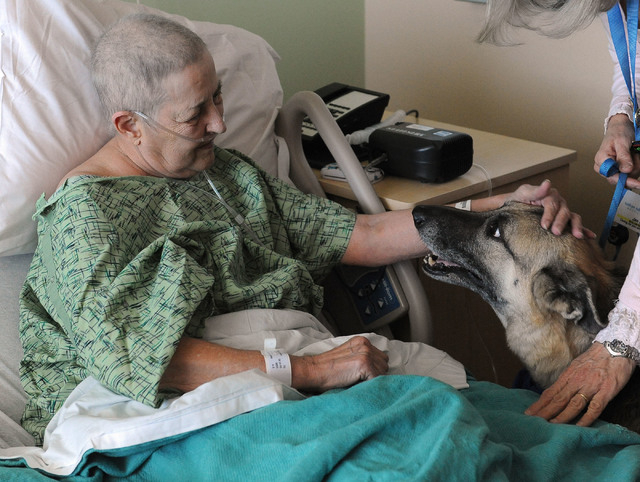Delivering a sense of solace, helped by paws and purrs

Lisa Browder opens the top drawer of one of her file cabinets. A bag of dog treats almost jumps out of the drawer. Kimber, the visiting German shepherd lying quietly beside owner Jan Hanson, knows good things are about to happen.
Browder says she has the best job in the world. This holiday season, she is leading the third dog bed and blanket drive sponsored by Nathan Adelson Hospice. New or gently used dog beds, blankets, towels, washcloths and unopened dog and cat food can be dropped off at a Nathan Adelson location through the end of January. Volunteers will take the collected items to local animal shelters.
Why the help for animal shelters? Because pets are part of the therapy team at the Swenson and Tenaya inpatient Nathan Adelson Hospice locations.
Browder manages the Bonnie Schreck Memorial Complementary Therapies Program. Hospice patients are promised they will not end life alone, afraid or in pain. Many times, Browder says, therapies outside of traditional medicine — pet therapy, massage, essential oils, reflexology, reiki, music and art — can greatly improve a patient’s comfort in the hospice surroundings.
Initial funding for the complementary therapies program, a distinctive part of the hospice’s services, came from local attorney Frank Schreck in honor of his late wife, Bonnie, a former Nathan Adelson Hospice patient.
Browder, who is also one of only three registered aromatherapists in Nevada, inherited a small pet therapy program when she joined Nathan Adelson Hospice eight years ago. Only three dogs were in the program. Today the program uses 21 dogs and one cat. Browder owns two cats, neither of which, she says with a laugh, would be acceptable as therapy cats.
The majority of the animals on the Nathan Adelson Hospice pet therapy team were originally adopted by their owners from shelters, hence, the interest in helping the shelters.
Every animal used for pet therapy at the hospice is a certified therapy animal. A tester observes the animal’s manners with strangers, other animals and in circumstances that could cause animals to become skittish. The tester has a checklist of questions: Can the animal remain obedient and calm when doors are opening and closing, when wheelchairs and walkers are passing, when they’re in the rooms of strangers?
Once certified and accepted into the Nathan Adelson Hospice program, therapy animals visit patients once a week and are scheduled for mornings, afternoons or evenings.
When an animal visits, animal owners walk into a patient room, introduce themselves and ask whether the patient wants to meet the animal.
“Some people may not want to see an animal,” Browder says, “but others who have had to be away from their animals or even had to give up their animals want to see and touch the animal. We even had one lady who insisted that Kimber, who’s not a small dog, climb into bed with her. Our goal is a calm, homelike environment, so Kimber climbed on up.”
Hanson says seeing a big smile on a patient’s face is the best reward for the dog owners. She adds that a therapy dog visit isn’t always just for patients.
“The staff members at a hospice have stressful jobs, too,” Hanson says. “One way or another, we are also spending time with the staffs.”
Studies have shown that a dog’s presence can lower a person’s blood pressure and heart and respiratory rates.
“In the hospice world,” Browder says, “we have patients who don’t want to take heavy medications because they want to be fully aware and awake when family members visit. Just being with an animal can help a patient to relax and sleep.”
Hanson adds, “Some patients for cultural or other reasons don’t feel comfortable sharing emotions, but being with an animal — hugging a dog, for example — can allow them to suddenly release their anxiety in an acceptable way.”
Kimber, at home, is a lively “wild child,” her owner says. But once she is told, “Want to go to hospice?” the dog heads for the clothes rack where her bandanna and hospice halter are kept, and she suddenly calms down.
“The dogs seem to know,” Hanson says, “that something special is going on at hospice that requires quiet.”
Hanson purposely parks a distance from the hospice building so Kimber can “take care of business” before entering. Kimber also has had a bath before every therapy visit.
Hanson volunteers as a massage therapist at an animal shelter, too.
“You have no idea how scared and frightened the animals are in a shelter,” she says. “The blankets and dog beds would be so welcome.”